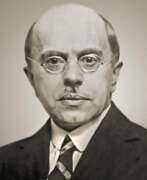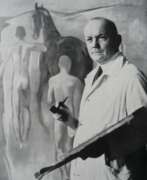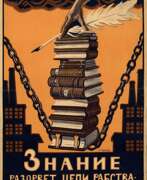Posterists 19th century


Hans Christiansen was a German painter, representative of classical modernism, decorator and illustrator.
Christiansen trained as a decorative painter in Flensburg and then at the School of Applied Arts in Munich, later studying at the Académie Julian in Paris. After a study trip to Italy in 1889, he moved to Hamburg, where he taught at the Technical University.
At the same time, Christiansen worked as a freelance decorative artist and was active in the Volkskunst-Verein, and was one of the founders and first residents of the Darmstadt artists' colony of the late 19th and early 20th century. Together with Josef Olbrich and Peter Behrens, he designed furniture, ceramics, tapestries, stained glass and graphic posters. He also designed his own house in the colony, which he called "Villa Rose," which was destroyed during World War II.
During this time, the versatile artist also wrote regularly for the magazine Jugend, creating many illustrations and covers. From 1911 he lectured at the Wiesbaden School of Arts and Crafts and was a member of the Wiesbaden Free Artists Association.
In 1933, Christiansen's work was banned by the Nazi Party of Germany because of his Jewish wife, and he was almost forgotten until his death in 1945.


Fritz Helmuth Ehmcke was a German graphical designer, typographer and illustrator. Ehmcke was educated as a lithographer in Berlin during 1893–1897. In 1900, he was a co-founder of Steglitzer Werkstatt. From 1903, he taught at the Kunstgewerbeschule in Düsseldorf, from 1913 to 1938 in Munich, during 1920-1921 also in Zürich. During 1946 to 1948, he was professor at the Academy of Fine Arts, Munich. He designed a number of typesets, notably Ehmcke-Antiqua and Ehmcke-Kursiv in 1909/10 (adopted for English-language typesetting by Stephenson Blake under the name Carlton).


Henri-Jacques-Edouard Evenepoel was a Belgian artist whose most important works are associated with Fauvism. The artist debuted a portrait of his cousin (Louise in Mourning) at the 1894 Salon des Artistes Français. He showed four portraits at the Salon du Champ-de-Mars in 1895 and continued to exhibit there until his death. His first solo exhibition came at the Brussels Cercle Artistique (December 1897 – January 1898). Family and friends were the artist's preferred subjects; his full-length portraits, often against a neutral background, show the influence of Édouard Manet and James Abbott McNeill Whistler. His Parisian scenes were influenced by Henri de Toulouse-Lautrec and Jean-Louis Forain. Though his early scenes had a somber palette, his paintings while in Algeria (where he first wintered during his solo exhibition) were very different in style, anticipating the bold colours of Fauvism (e.g., Orange Market, Blidah).


Eleanor Fortescue-Brickdale was a British Pre-Raphaelite painter, illustrator and stained glass artist.
At the age of 17, she enrolled at Crystal Palace School of Art and was later admitted to the Royal Academy of London and she initially worked with illustration. In 1897, Eleanor won a prize for her painting "Spring", which allowed her to begin work on her first large-scale oil painting, "The Pale Color of True Love". The painting was exhibited at the Royal Academy in 1899.
In 1902 Eleanor Fortescue-Brickdale was elected the first female member of the Institute of Oil Painters. She illustrated many books, including Tennyson's Royal Idylls in 1911. She taught at the Byam Shaw School of Art in Kensington. During the First World War, the artist designed posters for government departments and later several commemorative stained glass windows and a memorial in York Cathedral. In 1919 she became a member of the Royal Society of Watercolor Painters.


Albert Guillaume was a French artist, cartoonist, illustrator, and master of the poster.
Guillaume was a prolific illustrator: he worked for magazines, books, and almanacs, and his satirical drawings were published in Parisian humor magazines. He was also a painter and designer of theater posters and advertising posters. Working for the large Parisian printing company Camis, he designed a series of highly successful posters for commercial goods.


Albert Pieter Hahn was a Dutch political cartoonist, poster artist and book cover designer; well known for his socialist and antimilitaristic viewpoints. Some of his drawings, especially those of the railroad strikes of 1903, have been regularly used in history textbooks. His son-in-law, Albert Hahn jr., was also an artist, so he is sometimes referred to as "Sr.".


John Hassall was an English illustrator, known for his advertisements and poster designs. In 1895, he began work as an advertising artist for David Allen & Sons, a career which lasted fifty years. Between 1896 and 1899 alone, he produced over 600 theatre poster designs for this firm while, at the same time, providing illustrations to several illustrated newspapers. Making use of flat colours enclosed by thick black lines, his poster style was very suitable for children's books, and he produced many volumes of nursery rhymes and fairy stories, such as Mother Goose’s Nursery Rhymes.


Olle Hjortzberg, or Gustaf Olof Hjortzberg, is a Swedish painter, illustrator, and designer.
He studied at the Swedish Royal Academy of Arts, then traveled to Palestine, Syria and Greece.
Hjortzberg is known primarily as the author of colorful floral still lifes, but he also painted St. Katharina's Church in Stockholm and the cathedral in Uppsala and was a professor at the Royal Academy of Fine Arts. The artist illustrated the Bible and drew posters and stamps.
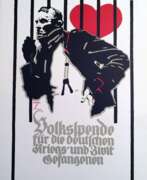





Heinrich Hönich, also known as Jindřich Hönich, was a Czech-German academic artist, graphic designer and teacher.
Hönich studied at the Prague Academy of Fine Arts and the Academy of Fine Arts in Dresden, and lived in Munich from 1906-1928, where he participated in many exhibitions. The artist was mainly engaged in landscape painting and graphics, but also created ex-libris and posters, worked in etching and lithography, was a skillful draughtsman and graphic artist.
From 1928 to 1945 Hönich worked as a professor at the Prague Academy of Art and raised a number of famous artists.
In 1944, Heinrich Hönich was included in the Gottbegnadet list of German artists compiled by the Imperial German Ministry of Public Education and Propaganda under the direction of Joseph Goebbels.


Ivan Semyonovich Kazakov (Russian: Иван Семёнович Казаков) was a Russian painter and graphic artist, known for his contributions to Orientalist art. Born on February 1, 1873, in Kasilova, Oryol Governorate, Kazakov studied at the Moscow School of Painting, Sculpture, and Architecture, and later at the Imperial Academy of Arts under the mentorship of Vladimir Makovsky.
Kazakov's work is notable for its vibrant depictions of Central Asian architecture and landscapes, particularly those of Samarkand, Bukhara, and Tashkent. His paintings often feature detailed portrayals of domes, minarets, and intricate patterns, capturing the essence of these historic cities. This unique focus on Orientalist themes distinguished him from his contemporaries and earned him a prominent place in Russian art history.
Throughout his career, Kazakov exhibited his works in significant venues in Saint Petersburg and Moscow. He also played a crucial role in the art community of Tashkent, where he taught and established his own studio. Several of his works are preserved in museums, including the State Russian Museum and regional art collections, which continue to attract art enthusiasts and collectors.
For updates on new works and auction events related to Ivan Semyonovich Kazakov, sign up for our exclusive alerts. Stay informed about the latest opportunities to acquire pieces by this remarkable artist.
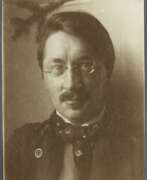

Erich Kuithan was a German artist of the late nineteenth and early twentieth centuries. He is known as a painter, graphic artist, graphic artist, illustrator and poster artist.
Erich Kuithan at different periods of his career was fascinated by modernism, symbolism and expressionism. His artistic legacy includes many paintings, drawings, illustrations, and designs for furniture, clothing, ex-libris, porcelain wares, and Art Nouveau advertising posters. Kuithan has conducted study tours, exhibited at art clubs, worked as an illustrator for magazines, and created illustrations for children's books.


Jean Lehmann was a Swiss painter, graphic artist and sculptor.
Jean graduated from the Lucerne School of Applied Arts, studied at the Academy of Fine Arts in Venice and at the Academy of Fine Arts in Munich. Lehmann worked at the Glacier Gardens in Lucerne and as a guide in mountain hotels, so many of his paintings are mountain snow-covered landscapes. The artist was particularly fond of painting rustic landscapes, rural scenes of quiet life, and he also created portraits and still lifes in a wide variety of techniques. He also painted a series of watercolors and chalk drawings of Swiss traditional costumes.
Lehmann also worked in the advertising business, creating posters for sporting events and travel companies.


Georges Lemmen is a Belgian Neo-Impressionist painter, member of the XX Society. He was close to art from childhood and studied for a time at a special drawing school. In the early 1880s, as a teenager, he was introduced to the work of Edgar Degas and Henri Toulouse-Lautrec, which had a great influence on him.
Georges Lemmen's paintings were marked by the use of fine, clean strokes and a vivid colour palette. He used the technique of divisionism, applying strokes of pure colour in close proximity to one another to create a sense of optical blending and luminescence.
Lemmen's subject matter was varied: landscapes, portraits, interiors and scenes of everyday life. He often portrayed leisurely pursuits and the beauty of nature, infusing his work with a sense of tranquillity and harmony.
Until 1895, he abandoned pointillism to contribute to the development of Belgian Art Nouveau. He created many book illustrations, posters, ceramics, carpets, drawings, pastels and gouaches in this style.


Amédée Ernest Lynen, who often signed his works Am. Lynen, was a Belgian painter, illustrator and writer. In 1880, he was one of the founders of the artistic group L'Essor after it had separated from the academy, and he co-founded its successor Pour l'Art in 1892. In 1895, he founded the "Compagnie du Diable-au-corps", an artistic association which organised evenings with theatre and poetry, and which existed at least until 1899. It also published a satirical newspaper, Le Diable au Corps. In 1903, two works on paper were bought by the Royal Museums of Fine Arts of Belgium. In 1930, a retrospective of his works was organised by the Cercle Artistique et Littéraire in the Vauxhall, Brussels.


Alexander Mikhailovich Lyubimov (Russian: Алекса́ндр Миха́йлович Люби́мов) was a prominent Russian realist painter, illustrator, graphic artist, and art educator, celebrated for his significant contributions to Russian art, especially during the Soviet era. Born on February 25, 1879, in Paltsevo, Kursk Province of the Russian Empire, Lyubimov is renowned for his mastery in painting and graphics, which often depicted the societal and political landscapes of his time.
Throughout his career, Lyubimov was deeply involved in art education, teaching at prestigious institutions such as the Leningrad Institute of Painting, Sculpture and Architecture, and the Higher School of Art and Industry named after Vera Mukhina from 1934 to 1955. His pedagogical work influenced a generation of Russian artists, including notable figures like Alexander Laktionov and Yuri Neprintsev.
Lyubimov's works are housed in esteemed collections worldwide, including the State Russian Museum and the State Tretyakov Gallery, underscoring his status in the art world. His artworks, characterized by their vivid realism and complex interplay of light and shadow, continue to attract the admiration of collectors and art enthusiasts globally.
For those interested in exploring the works and legacy of Alexander Mikhailovich Lyubimov, subscribing to updates on exhibitions and sales related to his art could provide valuable insights and opportunities to acquire pieces from this influential artist. This subscription service focuses solely on new product sales and auction events related to Lyubimov, ensuring that enthusiasts and collectors are well-informed of the latest offerings.


Johann Baptist Maier was a German commercial artist and painter. In 1905 he was a prize winner in a competition for advertising designs for joint advertising by the entrepreneurs Ludwig Stollwerck and Otto Henkell. Maier designed a number of covers for the magazine Die Dame and the 1922 book calendar. Maier worked in Munich from 1909 to 1942. He was a member of the second group The Six and the New Association of Munich Poster Artists. Johann Baptist Maier designed posters for the Marco Polo Tee, for the Kieler Herbstwoche, for the Fliege Blatter, Sporthaus Schuster Munich, among others. Between 1906 and 1925 he supplied almost 700 drawings for the Meggendorfer-Blätter.


Burkhard Mangold was a Swiss artist, poster designer, illustrator, painter, graphic artist, and stained glass artist. He created murals and was a pioneer of Swiss poster art, developing a unique style of his posters. He has been called the "grandfather of the Basel School.


Henri Georges Jean Meunier, a Belgian Art Nouveau artist, was renowned for his multifaceted talents as a lithographer, etcher, illustrator, bookbinder, and poster designer during the Belle Époque. Born into a family with artistic lineage, Meunier honed his skills in his father's workshop before diversifying his artistic pursuits. His works are celebrated for their strong imagery and use of flat colors, a technique inspired by Japanese prints, which gave his art a distinct and powerful visual appeal.
Henri Meunier's contributions to the art world were significant, particularly in the realm of lithography. His lithographs, frequently published in the prestigious L'Estampe Moderne, stand out for their vibrant colors and compelling designs. These works, alongside his color aquatints, which are lauded for their freshness and appeal, highlight his mastery in blending color and form to capture the viewer's attention.
Despite the scarcity of his works today, Henri Meunier's legacy in the Art Nouveau movement remains impactful. His ability to draw the viewer into his art through his innovative use of color and design made him a sought-after artist in Brussels around 1900. His artistic contributions continue to be celebrated, offering a glimpse into the vibrancy and dynamism of the Art Nouveau era.
For enthusiasts and collectors keen on exploring the unique artistry of Henri Georges Jean Meunier, staying informed about upcoming sales and auctions can provide an opportunity to own a piece of this artistic legacy. By signing up for updates, you can ensure you're the first to know about new product sales and auction events featuring Henri Meunier's captivating works.


Carl Moos, otherwise Karl Franz Moos was a German and Swiss artist and illustrator, notable for his Art Deco travel and sporting posters, particularly of skiing. He trained in commercial art in Munich and worked as an illustrator for, among others, the Münchener Tagespresse. He also established himself as a creator of postcards and posters. He was a member of the Munich commercial artists' group Die Sechs, which aimed to improve the standing of advertising and poster graphics. His posters are highly sought after in the art market.


Maurice Neumont, a French artist, was a prominent figure in the art world, particularly known for his work as a painter, lithographer, and illustrator. His artistic contributions were especially notable during the First World War, where he produced impactful posters for the French government, including the famous "They Shall Not Pass" poster. Neumont's art often conveyed strong messages and was characterized by its detailed and expressive nature, making a significant impact on public sentiment during the war.
Throughout his career, Maurice Neumont was also involved in illustrating for the Cornet Society menu collection and created several posters that were not only politically significant but also artistically influential. His works, such as "La guerre est l’industrie nationale de la Prusse" and "22me Salon Des Humoristes Au Palais De Glace," showcase his versatility and keen eye for detail.
For collectors and experts in art and antiques, Maurice Neumont's works offer a fascinating glimpse into early 20th-century French art and its intersection with historical events. His posters, in particular, serve as poignant reminders of the era's challenges and the power of art in shaping public perception.
For those intrigued by Maurice Neumont's profound impact on art and history, we invite you to subscribe for updates on exhibitions, sales, and auctions featuring his works. Stay informed and never miss an opportunity to explore and perhaps acquire pieces by this influential French artist.


Maxfield Parrish was an American painter and illustrator active in the first half of the 20th century. He is known for his distinctive saturated hues and idealized neo-classical imagery. His career spanned fifty years and was wildly successful: the National Museum of American Illustration deemed his painting Daybreak (1922) to be the most successful art print of the 20th century.


Emil Preetorius was a German illustrator, graphic artist, book designer and art collector. He is also considered one of the most important stage designers of the first half of the 20th century. In 1909, together with Paul Renner, he founded the Schule für Illustration und Buchgewerbe (School for Illustration and Book Design) in Munich, headed the Munich training workshops from 1910, and in 1926 became head of a class for illustration as well as a class for stage design at the Hochschule für Bildende Künste (Academy of Fine Arts) in Munich, where he was a professor from 1928. In 1914, together with Franz Paul Glaß, Friedrich Heubner, Carl Moos, Max Schwarzer, Valentin Zietara, Preetorius founded the artists' association "Die Sechs" (The Six), one of the first groups of artists for the marketing of advertising commissions, especially posters.
Preetorius created illustrations for numerous works of fiction from 1908 onwards. In 1932 he became scenic director of the Bayreuth Festival. In 1944 he made his debut as stage designer for the Richard Strauss premiere of Die Liebe der Danae at the Salzburg Festival. In his book cover designs, literary illustrations, advertisements and posters, Preetorius was influenced by Japanese woodblock prints; as a stage designer, he drew on Romantic classicism.


Pierre Roy was a French surrealist painter. He is known for his realistically painted compositions of ordinary objects in unexpected arrangements. After gaining his baccalauréat at the local school he joined a firm of architects before enrolling at the Ecole des Beaux-Arts in Paris. Disappointed with the course, he left to work on the designs for the 1900 Paris Exposition.
His work is classed as surrealism, and is based on assemblages of everyday objects such as shells, vegetables and fruits, woollen reels, ears and seeds, eggs and ribbons arranged to create poetic images.


Max Schwarzer was a German commercial artist and illustrator. In 1914, together with Friedrich Heubner, Valentin Zietara, Emil Preetorius, Franz Paul Glass and Carl Moos, he founded the artists' association The Six, one of the first groups of artists to market advertising commissions. Max Schwarzer drew for the satirical journal Simplicissimus. His carnival posters shaped the Munich carnival, such as In the Magic Garden of Regina (Carnival 1928) or Munich Carnival (1934). Max Schwarzer painted covers for the magazine Uhu in the New Objectivity style. In 1930 he made the Art Deco mosaics on the steamer Europa with Hans Gött. In the early 1920s, he illustrated the fairy tale volumes for the Munich Rösl publishing house with hand-colored pictures and ornaments.


Médard Tytgat was a Belgian painter, lithographer, book illustrator and poster artist known for portraits, nudes, and landscapes. From 1890 to 1894, he studied at the Académie Royale des Beaux-Arts of Brussels with Jean-François Portaels. He took part in the art competitions at the 1924 Summer Olympics. Tytgat was considered a mediocre painter, but was more highly regarded as an illustrator.


Émile van Doren, birth name Nicolas Émile van Doren, was a Belgian landscape painter. In 1892 he received the Donne Prize, which since 1888 has been awarded by the Brussels Academy for landscape painting. The landscapes in and around Genk, with their vast heathlands, ponds and undulating sand dunes, became the almost exclusive subject of his paintings.
Emile Van Doren's success as a landscape painter was considerable. Early in his career, the royal court bought some of his works.


Anna von Wahl (Russian: Анна Эдуардовна фон Валь) was a Baltic-German painter and illustrator, born in 1861 in Saint Petersburg and active until her death in 1938. Known for her delicate and evocative works, von Wahl studied at the Imperial Academy of Arts, where she honed her skills in graphic art and illustration.
Von Wahl's artistic career spanned six decades, during which she created numerous illustrations and paintings that reflected the socio-cultural dynamics of her time. Her work often depicted family and children's scenes, infused with a gentle, sentimental quality. One of her notable works, "Stimmungsbilder" (Mood Pictures), is a collection of illustrations known for its tender portrayal of everyday life.
In addition to her illustrative works, von Wahl's paintings were also well-regarded. Her art was exhibited in several galleries, and she was a member of various artistic associations. Although not as widely recognized today, her contributions to the art world during her lifetime were significant, reflecting the aesthetics and sensibilities of late 19th and early 20th-century Baltic-German culture.
For those interested in exploring more about Anna von Wahl and her works, consider signing up for updates on auction events and new product sales related to her art. This will ensure you stay informed about opportunities to view and acquire her unique pieces.


William Blamire Young, commonly known as Blamire Young, was an English/Australian artist who painted primarily in watercolour. In 1911 he held an exhibition at Melbourne of small pictures, some of which had similar qualities to the Japanese coloured wood-cuts of the eighteenth century. He was commissioned by the Postmaster-General of Australia, Charles Edward Frazer, to produce new designs for the first Commonwealth of Australia stamps. This design was first issued on 2 January 1913 and continued to be in use till 1935 concurrently with other stamps. In 1976 he was honoured on a postage stamp issued by Australia Post for his work as designer of the first Australian postage stamp.


Valentin Zietara was a German-Polish graphic artist working in Munich. In 1914, together with Franz Paul Glass, Friedrich Heubner, Carl Moos, Emil Preetorius and Max Schwarzer, he founded the artists' cooperative The Six, one of the first groups of artists to market advertising commissions, specifically posters. On June 2, 1931, a working group of Munich poster artists was formed under the name New Association of Munich Poster Artists, which included Ehlers, Ludwig Hohlwein, Lindner and Zietara. The purpose of the community was "to bring the artistic design of the poster back to the fore". Together with Ludwig Hohlwein, Valentin Zietara was one of the most influential commercial artists in southern Germany at the beginning of the 20th century. His posters for the Pschorr Brewery, for the Café Königsbau in Augsburg, for the Adler cigarette factory, for Nelson Fahrrad, Lodenfrey, Feurich Biscuit, Schwaben Bräu Bock, Honig Gautsch Munich, or political posters for the German People's Party became famous. Zietara designed the cover page of the monthly magazine for the promotion of artistic advertising, which is dedicated to the city of Munich and its artists.






